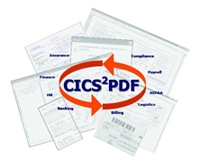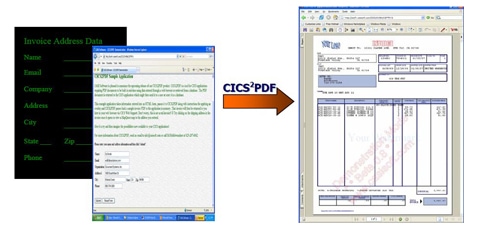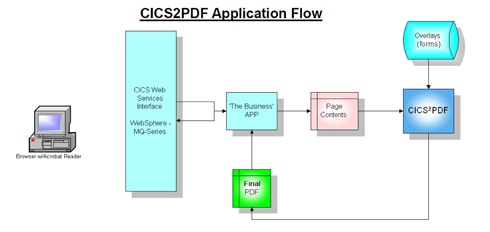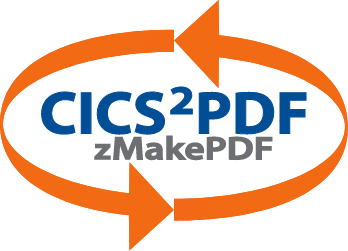CICS2PDF Overview
 Web-enabling CICS applications to deliver critical business information to employees, customers, and partners is a critical element of today’s ‘on demand’ business environment. While most transactional content is presented via HTML or XML for viewing and other post-processing activities, PDF is the standard for final-form document viewing, printing and archiving.
PDFs can be password-protected and encrypted. They retain their security even when stored or forwarded.
Consistent Presentation: A PDF will look and print the same everywhere. Documents can lose meaning and value if the layout or visual emphasis is altered.
Information Integrity: A PDF contains all of the graphics, fonts, and instructions in a self contained package that can be easily stored and transported. HTML assembles all of the components from separate files. A PDF easily handles multiple pages while HTML does not readily handle or understand the concept of pages.
HTML and XML are transient in nature, whereas a PDF can be saved, forwarded and archived intact. This is the reason government and commercial organizations around the world are standardizing on PDF for electronic documents.
The free Adobe Reader ® is installed on virtually every Internet connected PC and comes bundled with 60% of all PDAs. Anyone on any platform can read PDF files.
Web-enabling CICS applications to deliver critical business information to employees, customers, and partners is a critical element of today’s ‘on demand’ business environment. While most transactional content is presented via HTML or XML for viewing and other post-processing activities, PDF is the standard for final-form document viewing, printing and archiving.
PDFs can be password-protected and encrypted. They retain their security even when stored or forwarded.
Consistent Presentation: A PDF will look and print the same everywhere. Documents can lose meaning and value if the layout or visual emphasis is altered.
Information Integrity: A PDF contains all of the graphics, fonts, and instructions in a self contained package that can be easily stored and transported. HTML assembles all of the components from separate files. A PDF easily handles multiple pages while HTML does not readily handle or understand the concept of pages.
HTML and XML are transient in nature, whereas a PDF can be saved, forwarded and archived intact. This is the reason government and commercial organizations around the world are standardizing on PDF for electronic documents.
The free Adobe Reader ® is installed on virtually every Internet connected PC and comes bundled with 60% of all PDAs. Anyone on any platform can read PDF files.
 When the application and data are already in CICS, it makes sense to create final-form documents inside CICS itself. Passing data to other applications and/or platforms increases the development time and operational problems. There is significantly less support required when the document is built within CICS as compared to a multi-tier solution.
For PDFs that require encryption and locking, creating the PDF inside of CICS ensures that the data never leaves the mainframe unprotected.
A single application can retrieve the request, compose the PDF, send it, update a database to record the event, and even store a copy of the actual PDF into Db2… All in one ‘Unit of Work’!
When the application and data are already in CICS, it makes sense to create final-form documents inside CICS itself. Passing data to other applications and/or platforms increases the development time and operational problems. There is significantly less support required when the document is built within CICS as compared to a multi-tier solution.
For PDFs that require encryption and locking, creating the PDF inside of CICS ensures that the data never leaves the mainframe unprotected.
A single application can retrieve the request, compose the PDF, send it, update a database to record the event, and even store a copy of the actual PDF into Db2… All in one ‘Unit of Work’!


